France has officially commenced construction of its next-generation nuclear-powered aircraft carrier—known as PANG (Porte-Avions Nouvelle Génération)—with the fabrication of the first K22 naval reactor units. This milestone marks a significant leap in European naval capabilities and signals France’s commitment to sustaining a blue-water navy centered around nuclear propulsion and carrier strike operations.
PANG Program Overview: Replacing Charles de Gaulle
The PANG program is France’s flagship naval modernization initiative aimed at replacing the aging Charles de Gaulle—Europe’s only operational nuclear-powered aircraft carrier—by the late 2030s. The new vessel is expected to enter service around 2038–2040 and will form the centerpiece of France’s Carrier Strike Group (CSG) into the second half of the 21st century.
The ship will be significantly larger than its predecessor, displacing approximately 75,000 tonnes compared to Charles de Gaulle’s 42,500 tonnes. It will be around 300 meters long and feature an electromagnetic aircraft launch system (EMALS), enabling operations of heavier and more advanced aircraft such as the future SCAF/FCAS sixth-generation fighter jet. The PANG will also support E-2D Advanced Hawkeye AEW&C aircraft and various UAV platforms.
The program is led by Naval Group in partnership with Chantiers de l’Atlantique for hull construction and TechnicAtome for reactor design. The French Alternative Energies and Atomic Energy Commission (CEA) oversees nuclear safety and integration.
K22 Reactor Units: Core of Nuclear Propulsion
The key technological advancement underpinning PANG is its twin K22 pressurized water reactors. Developed by TechnicAtome in collaboration with CEA, each K22 unit delivers approximately 220–250 MW thermal power—roughly double that of the older K15 reactors used aboard Charles de Gaulle.
Fabrication of these first two reactor blocks began in early October 2025 at TechnicAtome’s facility in Le Creusot. These units are designed for improved safety margins, longer refueling intervals (up to 10 years), reduced maintenance overheads, and enhanced energy efficiency. Their modular design also facilitates integration into a more compact yet powerful propulsion architecture.
This milestone follows several years of design maturation since President Emmanuel Macron formally announced the program in December 2020 at Framatome’s Le Creusot site—a symbolic location for France’s civil-military nuclear industry base.
Industrial Ecosystem and Strategic Autonomy
PANG represents a critical pillar in preserving France’s sovereign defense industrial base across multiple domains:
- Nuclear Propulsion: CEA and TechnicAtome ensure continuity in military-grade naval reactors.
- Shipbuilding: Naval Group leads systems integration while Chantiers de l’Atlantique handles hull fabrication.
- Aviation Systems: Dassault Aviation is developing next-gen carrier-based fighters under FCAS/SCAF.
- Sensors & Combat Systems: Thales is expected to provide radar suites (likely based on Sea Fire family) and integrated combat systems.
The project sustains thousands of high-skilled jobs across France over multiple decades. It also reinforces Paris’ strategic autonomy doctrine by ensuring that key military capabilities—from deterrence to power projection—remain under national control without reliance on foreign suppliers or platforms like U.S.-built carriers or British-American EMALS technology (though EMALS for PANG will still be sourced from General Atomics).
PANG Capabilities Compared to Global Peers
PANG will place France among a small group of nations operating large-deck nuclear carriers capable of sustained global power projection. While it remains smaller than U.S. Navy Ford-class supercarriers (~100,000 tonnes), it will surpass Britain’s Queen Elizabeth-class (~65,000 tonnes) both in displacement and endurance due to nuclear propulsion.
Key capability highlights include:
- Twin EMALS catapults: Enabling launch of heavy fixed-wing aircraft including AEW&C platforms.
- Nuclear endurance: Unlimited range limited only by food/supplies; up to 10 years between refueling outages.
- Air wing capacity: Estimated at ~30–40 fixed-wing aircraft plus rotary/UAV assets.
- C4ISR suite: Likely based on Thales’ latest radar/electronic warfare architecture integrated with NATO Link-16/Link-22 standards.
- Crew size: Expected ~2000 personnel including air wing; optimized via automation compared to legacy carriers.
This positions PANG as Europe’s most capable naval platform once commissioned—offering full-spectrum air-sea dominance from strike missions to ISR roles within NATO or autonomous French deployments worldwide.
Toward Sea Trials: Timeline Through 2040
The current timeline anticipates steel cutting for hull modules beginning in late 2025 or early 2026 at Saint-Nazaire shipyard. Major milestones include:
- 2025–2026: Reactor fabrication begins; detailed design finalization; long-lead items ordered.
- 2027–2030: Hull assembly ramps up; combat systems integration starts mid-decade.
- 2034–2036: Initial harbor trials; EMALS testing; crew training pipelines initiated.
- 2037–2038: Sea trials commence; reactor commissioning under CEA supervision begins late decade.
- CIOC (Commissioning Into Operational Capability): Targeted for ~2038–2040 depending on test outcomes and budgetary pacing.
This schedule aligns with projected retirement timelines for Charles de Gaulle, ensuring no capability gap in France’s blue-water naval aviation posture during transition phases. However, any delays—particularly in EMALS delivery or reactor certification—could compress training windows or require life-extension measures for the current carrier fleet beyond planned dates.
The Strategic Significance for NATO and Beyond
PANG not only secures France’s status as Europe’s leading maritime power but also enhances NATO’s collective expeditionary capabilities. As one of few allies able to deploy a full-size CATOBAR (Catapult Assisted Take-Off But Arrested Recovery) carrier group independently, France offers unique interoperability value during joint operations—from Indo-Pacific deterrence patrols to Mediterranean crisis responses alongside U.S., UK or Italian forces.
The vessel also serves as a testbed for integrating future unmanned aerial systems (UAS) into carrier air wings—a key evolution area as NATO navies explore manned-unmanned teaming concepts under programs like NGRC or FCAS Maritime variants. Additionally, its robust ISR/C4ISR suite supports persistent surveillance roles across contested maritime zones where peer adversaries deploy A2/AD bubbles backed by hypersonic threats or EW denial tactics—a scenario increasingly relevant vis-à-vis China or Russia’s naval posturing strategies.










